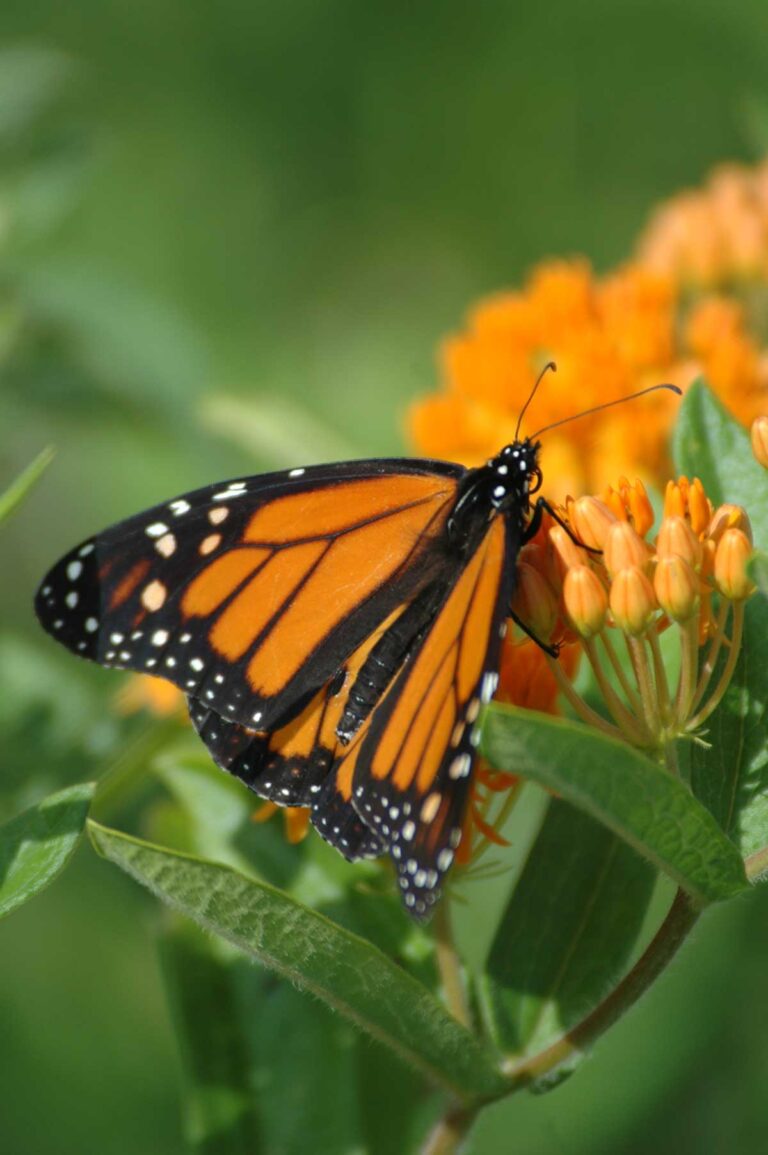Monarch butterflies are one of North America’s most recognizable and beloved species, but their populations have declined sharply in recent decades. Habitat loss, pesticide use, and the spread of non-native plants have all played a role.
Fortunately, gardeners, farmers, and landscape professionals in the Northeast can take direct, meaningful action to support monarch butterfly conservation by creating butterfly-friendly spaces rooted in native ecology.
This blog outlines the essential, science-backed strategies for building a monarch habitat that actually works. In it, you’ll learn:
- Why milkweed is non-negotiable, and which species to plant
- Which native nectar plants best support adult butterflies
- How to design your garden for visibility, success, and low maintenance
- What to avoid when it comes to pesticides and herbicides
Let’s begin with the cornerstone of any monarch garden: native milkweeds.
1. Grow Native Milkweeds – Host Plants for Monarch Caterpillars
Monarch butterflies cannot reproduce without milkweeds. Milkweed plants (genus Asclepias) are the sole host plants on which monarch females lay their eggs, and the only food source for the hatching caterpillars. In short, no milkweed means no monarchs, so planting milkweed is the single most important step for monarch butterfly conservation.
Choose Milkweed Species That Are Native to Your Region
Native milkweeds are adapted to the local climate and will support monarchs without the potential problems that non-native species might cause. For the Northeastern US, suitable native milkweeds include:
- Common Milkweed (Asclepias syriaca)
- Swamp Milkweed(A. incarnata)
- Butterfly Milkweed (A. tuberosa)
These species have demonstrated value for monarchs in the region and are relatively easy to grow. Common and swamp milkweed are often favorites: research shows monarch females readily lay eggs on both, and they support vigorous caterpillar growth.
A Note on the Longevity of Butterfly Milkweed
Beware that Milkweed can be short-lived and typically has a 5 year stand limit. In addition, it doesn’t tend to regrow in the same spot.
To maintain its presence in your planting, consider reseeding every few years to replenish thinning patches. Leaving seed pods on the plant through late summer and fall can also allow seeds to disperse naturally.
If you’re replanting Milkweed, try rotating its location slightly to mimic natural dispersal and improve establishment.
What Plants to Avoid for Monarch Butterfly Conservation
In the Northeast, it’s best to avoid tropical milkweed (Asclepias curassavica) and other non-native milkweeds that are not adapted to the region. Another non-native to skip is Black swallow-wort (Cynanchum louiseae), an invasive vine in the milkweed family: monarchs mistakenly lay eggs on it, but their larvae cannot survive on this toxic plant. Be sure to remove any swallow-wort if it’s in the area, rather than planting it.
2. Provide Abundant Nectar Flowers for Adults
While milkweed is essential for monarch breeding, a truly butterfly-friendly garden must also offer ample nectar sources for adult monarchs (and other pollinators) throughout the growing season.
Prioritize Native Wildflowers for Monarch Butterfly Conservation
Native plants are often the best nectar sources because monarchs (and native bees) recognize and utilize them. Diversity, however, is just as important as plant choice. Polycultures, a mix of native species with overlapping bloom times, provide a continuous food source from late spring through late fall. Aim for a dynamic mix of plants to support pollinators and keep your habitat thriving all season long.
Early in summer, Golden Alexanders (Zizia aurea) provide early nectar for adult Monarchs if they arrive early or during spring migration. It’s not a host plant, but it can be a solid companion to milkweed in a Monarch-supporting planting.
As summer progresses, milkweeds themselves produce nectar-rich blooms (milkweed flowers are very attractive to many butterflies, bees, and hummingbirds). However, monarchs and other pollinators will nectar on a wide range of flowers. Some top choices include:
- Purple Coneflower (Echinacea purpurea)
- Black-eyed Susan (Rudbeckia hirta)
- Marsh Blazing Star (Liatris spp.)
- Wild Bergamot (Monarda fistulosa),
- Ironweed (Vernonia spp.)
- Goldenrods (Solidago spp.)
- Asters (Aster novae-angliae)
Monarchs heavily utilize fall-blooming species like goldenrods during the migration period, so including these plants can directly support the butterflies’ journey south.
Follow These Basic Principles When Selecting Nectar Flowers
When selecting nectar plants, also consider flower shape and color. Monarchs have a long proboscis and are attracted to clusters of small flowers or composite blooms that they can easily land on. They often love pink, orange, red, purple, and yellow blooms.
Plant in clumps or drifts (3-5 or more of each species together) to create a target-rich foraging area; a large swath of one color/flower type is easier for butterflies to locate than scattered single plants. Clustering also yields a more striking visual display for you!
3. Design Your Garden for Monarch Butterfly Conservation: Layout and Habitat Features
Beyond what you plant, how you arrange and manage your monarch garden can influence its success. Here are some layout and design best practices for an effective butterfly-friendly garden:
Provide Plenty of Sunshine
Choose an open, sunny location for your monarch habitat. Most butterfly-attracting plants (milkweeds and nectar flowers alike) need abundant sun to grow and produce nectar.
A good rule of thumb is at least 6 hours of direct sun per day. If full sun is scarce in your yard, prioritize milkweed and nectar species that can handle part sun (e.g., asters) for those spots, but generally, sunnier = better for a monarch waystation.
Cluster Plants for a “Target-Rich” Habitat
Rather than dotting single plants around, plant your milkweeds and nectar flowers in clusters or close groupings. This creates a visual beacon that is more likely to attract egg-laying female monarchs and foraging adults.
A somewhat thick stand of milkweed and wildflowers is ideal for monarch butterfly conservation; you want the area to feel like a little wild sanctuary. Just avoid planting so densely that plants are overcrowded or shading each other out. A good spacing rule is to plant milkweeds about 18–24 inches apart in clusters, and interplant nectar flowers in gaps and edges.
Include a Water Source and Resting Spots
Butterflies do occasionally “puddle” in shallow water or mud to get moisture and minerals. You can create a simple butterfly puddling station by setting out a shallow dish or birdbath with wet sand and a few flat rocks.
Plan for Easy Maintenance
Design your habitat in a way that you can maintain it without too much disturbance. For example, if you’ll need to mow around it, consider a neat border (even just a mowed grass path or some stones) to delineate the wild area. In larger properties or farms, habitat strips can be along fences or ditches where they won’t interfere with farm operations.
Polycultures—plantings that mix multiple native species—can reduce the need for weeding and improve resilience over time.
Remember, no effort is too small. Even a patio container with a milkweed plant and some lantanas can contribute to monarch butterfly conservation.
4. Create a Safe Haven: Avoid Pesticides
Many pesticides are non-selective, meaning they will kill butterfly larvae (caterpillars) just as readily as the “pest” insects. Even chemicals marketed for mosquito or Japanese beetle control, for example, can drift and kill monarchs or contaminate their food plants.
Here are key points to keep your garden safe for monarchs and pollinators:
Do Not Use Systemic Insecticides
Neonicotinoids (imidacloprid, clothianidin, thiamethoxam, etc.) or similar chemicals like fipronil and sulfoxaflor are absorbed into plant tissues and can linger for months, making the nectar, pollen, and leaves toxic to any insect that feeds on them.
Check any product labels in your garage. If they have these active ingredients, dispose of them safely and do not use them. When buying plants, verify they are neonicotinoid-free as well.
Use Herbicides Sparingly, If At All
Herbicides (weed killers) can indirectly hurt monarchs by killing off the very plants they need.
If invasive weeds encroach, carefully spot-treat or hand-pull rather than spraying broadly. Never spray herbicides on milkweed or near your nectar plants; even a small drift could kill them. It’s better to pull weeds around milkweed by hand. It’s a little more labor, but monarchs will thank you for it.
Beware of Mosquito Control Treatments
Some lawn care companies or neighborhood programs spray for mosquitoes, but those insecticides (often pyrethroids) are highly toxic to butterflies and bees.
If you have a monarch waystation, consider opting out of any community mosquito fogging, and educate neighbors about alternative mosquito control methods (like removing standing water, using BT dunks in water, etc.).
In summary, treat your monarch habitat as a sanctuary from chemicals. Healthy gardens have robust ecosystems, not sterile, insect-free zones. With good plant selection and cultural practices, you can avoid the perceived need for pesticides entirely.
Use a Conservation-Focused Seed Supplier: Ernst Conservation Seeds
Monarch butterfly conservation starts with informed planting choices. By incorporating native milkweeds, prioritizing polyculture meadows, providing season-long nectar sources, avoiding chemical treatments, and designing your layout with monarch behavior in mind, you’re doing more than just creating a pretty garden—you’re building critical habitat that supports one of the most awe-inspiring migrations on the planet.
Every yard, field margin, or community plot that adopts these principles becomes part of a broader conservation network, helping to stabilize monarch populations across the United States.
If you’re unsure which species are right for your property or how to tailor your planting plan to your site conditions, Ernst Conservation Seeds is here to help. Our team of experts offers deep knowledge of native plants and habitat restoration, especially in the Northeastern U.S. Reach out today to get customized guidance for your project and take the next step in supporting monarchs where it counts.

